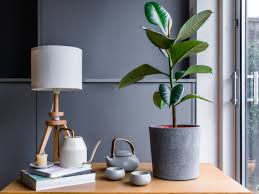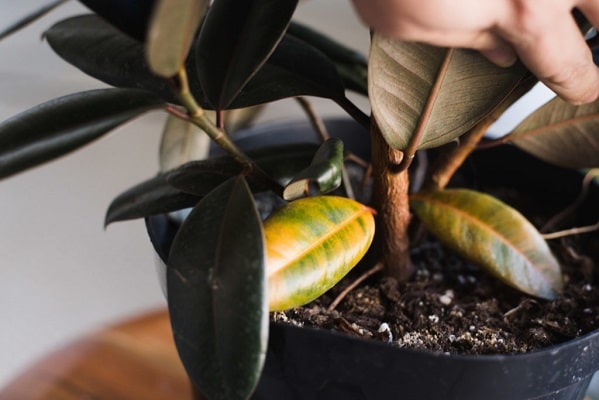Plant Care
Everything You Need to Know About Rubber Fig
Scientific / Botanical Name: Ficus elastica
Common Name: Rubber fig, Burgundy Rubber Tree
If you want a stunning indoor plant, the Burgundy Rubber Tree can be y our best option. It features glossy leaves in black or burgundy red color. Because it is a plant native to the tropical regions and rainforests of South America and India, it is common for the plant to adapt easily to any kind of environment and temperature. By simply giving it bright light throughout the day, some water and humidity, and a little care, expect your Burgundy Rubber Tree to thrive well in your living spaces.
How to Grow and Care for the Burgundy Rubber Tree?

Follow this guide in growing and caring for your Burgundy Rubber Tree at home. Learn what the plant requires when it comes to watering, lighting, humidity, temperature, and special care.
Burgundy rubber Tree

· LIGHT
The Burgundy Rubber Tree grows and thrives best in an area where it gets bright, indirect light. To keep the vibrant color and shine on the leaves, provide the type of light it needs. However, this plant can tolerate low light, making it an ideal houseplant and ornamental plant. But if you want the plant to be at its best, make sure that it receives sufficient light. The best way to keep it healthy and vibrant in color is to place it near a window to enjoy filtered light.
· WATER
The best time to water the burgundy Rubber Tree is when the soil is dry up to at least 50% to 75%. Water is vital to the plant’s growth and beauty, but overwatering and moist on the leaves may cause the plant to die. It is best to direct the water into the soil and let it flow through the drainage hole. No excess water should be left in the saucer, too, to prevent “wet feet.”
· TEMPERATURE
Temperature is also important in keeping the plant thriving indoors. The average room temperature for this plant is 65 to 78 degrees. However, the plant may suffer if the temperature drops to 55 degrees and below. Also, it is not good for the plant if the temperature suddenly changes.
· HUMIDITY
Humidity is needed to keep the plant in good shape. The Burgundy Rubber Tree enjoys the extra humidity, especially during the warm summer days. Misting the plant is a way to increase humidity, as well as to remove dust and mites from the leaves.
· FOOD
Fertilizer is essential to nourish the plant. A diluted fertilizer can be given to the plant at least once a month during the spring and summer season. During the cold months of the winter season, when the plant is at rest, there is no need to feed the plant.
· TOXICITY
The toxicity level of the Burgundy Rubber Tree is mild. When ingested, humans and pets may experience mild irritation in the stomach and mouth, which may lead to possible vomiting.
· ADDITIONAL CARE

The Burgundy Rubber Tree is easy to care for. It may need extra trimming and pruning depending on the height you desire. The new sprouts on top of the plant can be cut off for propagating purposes. In addition, to keep the plant in proper shape, the branches can also be trimmed off. To clean and keep the leaves glossy, you can use a soft sponge dipped in warm water and gently rub it on the leaves. A liquid hand soap, on the other hand, can be used to lift off the stain on the leaves.
Why the leaves of Burgundy Rubber Tree turn yellow?

The leaves, which should be burgundy red and black in color, may turn yellow due to some reasons. Let’s get to the bottom of the problem to apply the best solution.
· Due to improper soil Moisture
Because of improper soil moisture, the leaves of your Burgundy Rubber Tree turn yellow in color. When the plant is overwatered, or when soil is left wet for a long while, it affects the roots. To prevent it, watering should be done when soil is already dry 2” to 3” from the top of the soil.
The proper way of watering the plant is to let the water flow freely through the soil, reaching the bottom part. If there is excess water in the saucer, make sure that you discard it right away to avoid the root from “wet feet.”
Soil moisture is important but it should be given properly and consistently. It will only cause stress on the plant if watering is done inconsistently, or by alternating dry soil and wet soil frequently.
· Due to Low Humidity
If soil is too dry and the plant lacks moisture, it means that the humidity in the room or area is low. It causes the leaves to turn yellow and its edges brown. The leaves also become limp and droopy. Increasing the humidity by misting the plant will provide a solution to this problem.
· Due to Improper Lighting
Light is a top necessity to keep the plant healthy and alive. Its leaves also need sufficient light. However, long exposure under full and direct sunlight may cause sunburn to the leaves. Filtered light will do, and if the plant is desired to be in minimal growth, it can be placed in low light areas.
· Due to Pest Infestation
A pest infestation can also affect the plant, causing its leaves to turn yellow. Weak Burgundy Rubber Tree is also prone to pest attacks. Insects like bugs, spider mites, and scale suck the moisture and nutrients of the plant, leaving the plant unhealthy. Once you notice these insects and pests on the leaves, it is best to remove them right away. Don’t wait for the leaves to turn yellow before you do something. Also, make sure that the Burgundy Rubber Tree is healthy and strong.
· Yellowing of Leaves is Natural
It is normal for the leaves of the Burgundy Rubber Tree to turn yellow when the leaf matures and new growth sprouts. When you see new growths at the bottom of the plant on top of the soil, expect some of the leaves to turn yellow. This is the natural way of the plant to conserve its energy for the new growths.
Why the leaves of Burgundy Rubber Tree turn green?

Instead of burgundy red color, the leaves turn green. Why is this happening to your plant?
· Because of Improper Lighting
One of the reasons why the color of the leaves fades is because of improper lighting. The Burgundy Rubber Tree prefers bright light and indirect, filtered sunlight. It can tolerate low light but the dark, burgundy color of the leaves will turn into green.
You can help your plant maintain its stunning and gorgeous color by finding a sunny spot for it. Place it in a place where it can enjoy the light from the sun for a couple of hours only to prevent sunburn.
· Because the Plant Needs Extra Care
The leaves turn yellow because it signals that it wants some attention. It could be a quick trim or a thorough soak in water.
